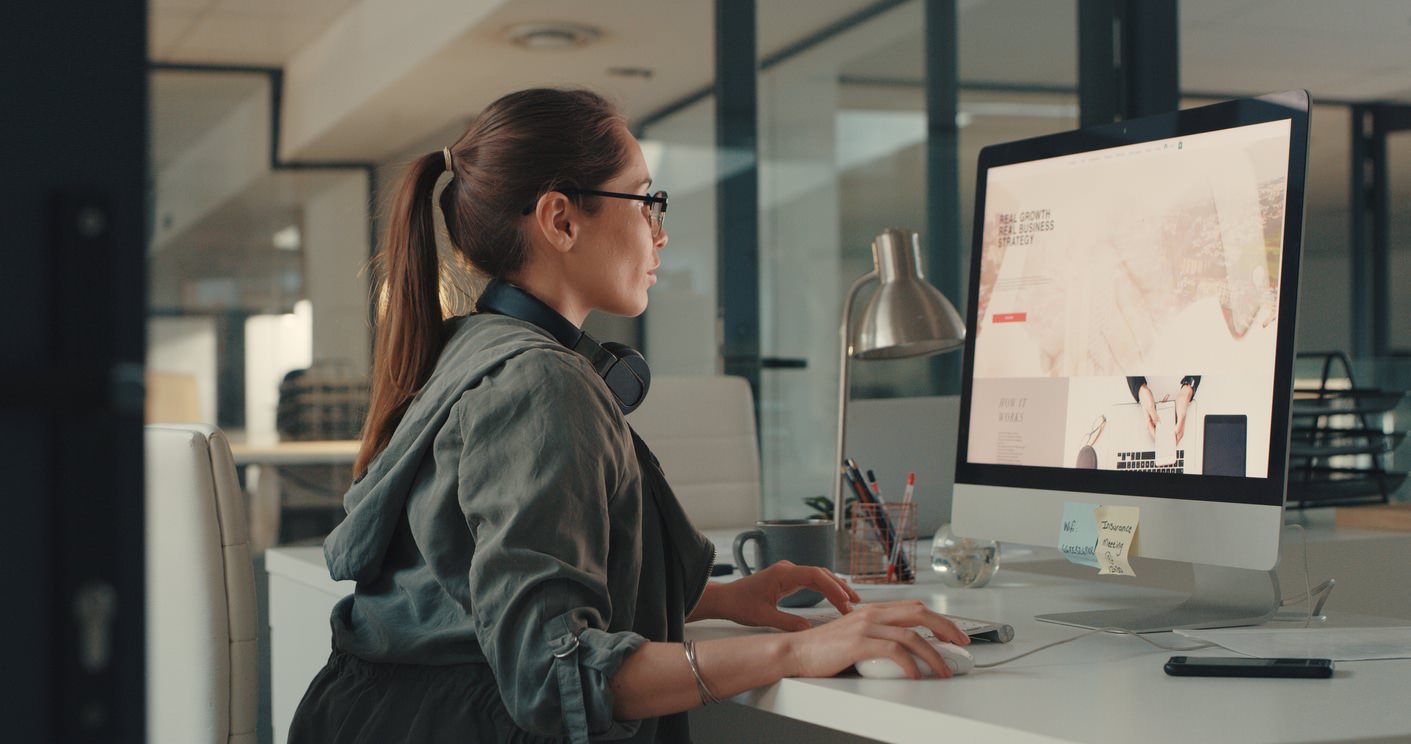We are truly living in a digital age. With over 90% of Americans regularly using the internet to perform a wide range of daily tasks, including actions related to shopping and researching products or services, a strong website has become an essential marketing tool for every business. To ensure your website performs well and achieves your marketing goals, it must be constructed well from both a visual and technical standpoint.
There are different specialists required to ensure the visual and technical aspects of your website work properly – web designers and web developers. While these two professionals work together and have some overlapping roles, their skillsets are somewhat distinct. They play a complementary role in bringing your website to life, and both are equally critical to the success of your digital marketing efforts.
One of the benefits of working with a website design and development company is that there will be optimal levels of collaboration between your website designer and developer. This ensures proper alignment between the website design and website development aspects of the process, allowing you to have a highly performing website that conveys your brand messaging, generates leads, and grows your business.
What Does a Website Designer Do?

What Does a Website Designer Do?
The website designer creates the visual and graphical elements of your website. They focus on the overall layout, aesthetics and usability of the website. Your web designer works to make sure your website is visually appealing and provides a good user experience.
The key elements of your website that are handled by the web designer include:
- Layout and design – The overall layout and design determines how important items such as logos, navigation menus, headers, footers, text, and graphical/video elements are arranged on each page.
- Branding and colors – Your website should convey your company’s brand. This includes any logos, icons, colors and fonts associated with your branding. When these elements are addressed properly on your website, it helps you make a better connection with your audience and ensures your website will look and feel consistent with your other marketing assets.
- Graphics – The graphical elements of your website refer to any photos, illustrations, infographics and other images used. The graphical elements your website designer chooses should complement your branding and enhance the overall layout of your site.
- Hierarchy – The visual hierarchy plays an important role in your ability to make a good impression on users, attract potential leads, collect user information and generate sales. An effective hierarchy will ensure calls to action (CTAs), headers and graphical elements are placed in a way that will most effectively achieve your marketing goals.
- Navigation – One of the most important functions associated with website design is making sure users can easily move around the site to find the info they’re looking for. The navigation structure plays a critical role in accomplishing this function. An effective navigation menu should be highly visible, easily accessible and intuitive. Websites with a poor navigation structure will make it hard for users to find what they need, resulting in a poor experience that may drive visitors away from your site.
Read our Helpful Web Design and Development Articles
Types of Website Designers

Types of Website Designers
There are specializations within the web designer role. Each of these specializations is critical to the success of your website. While some designers may be able to perform all these roles, it is also common for web design and development agencies to have different designers who specialize in each niche:
- User Experience (UX) Designer – The role of the UX designer is to make sure the website is structured in an engaging way that provides a good experience for all visitors interacting with it. In order to accomplish this, they must conduct thorough research into the demographics and needs of your target audience and test a variety of options to arrive at the design that will most effectively engage your audience and keep them coming back again.
- User Interface (UI) Designer – While the UX designer creates the foundation for a strong user experience, the UI designer works to ensure the website aesthetics (the look and feel) is designed in a way that will maximize conversions. This role is responsible for creating the graphics and typography that will optimize the layout of your website. The UI designer also creates a variety of elements such as CTA buttons, dropdown menus, navigational components, data fields and message boxes that make it easier for the user to interact with your website and complete your desired actions.
- Visual Designer – The visual designer combines certain aspects of the UX and UI design roles to make sure the website is both easy to use and visually appealing. They help bring your brand’s style and tone to life in order to improve the user journey.
What Does a Website Developer Do?
The website developer performs the behind-the-scenes coding and programming that allows your website to function properly. The developer works to bring the designer’s ideas to life by constructing the actual website. Website developers must work closely with the designer(s) in order to ensure all the design elements of the website work properly.
The key elements of your website that are handled by the web developer include:
- Programming – Front-end coding languages such as CSS, HTML and JavaScript are used to convert the design into a fully functioning website.
- Optimization – Whether they are building a custom website or working off of a website theme from a third-party platform such as WordPress, Drupal or Joomla, developers optimize the website by eliminating any unnecessary code that will cause it to be bloated and slow. In addition, the optimization process involves making sure the website will function properly and provide a great experience on all devices (desktop, tablet and mobile) by implementing best practices such as responsive design.
- Structure – Developers are responsible for making sure the coding of your website is structured properly. This improves load time, even for very large, complex websites.
- CMS operations – It’s common to build websites using a CMS (content management system) such as WordPress. When these platforms are used, developers must be able to manipulate the framework of the existing CMS to ensure your website’s design is integrated properly.
Types of Website Developers

Types of Website Developers
As with designers, there are specializations within the web developer role. Each specialization is critical to the success of your website. In general, website developers can be classified into the following roles:
- Front-end developer – Front-end developers are responsible for the coding and programming of the visual elements of the website that the user experiences and interacts with. They bring all of these elements to life in the finished website, ensuring it has the proper look and feel that will resonate with your target audience. This includes just about everything that your website users see, such as colors, text styles, images and graphics, buttons, forms and the navigation menu. In addition, the front-end developer is responsible for making sure the website works properly on all devices.
- Back-end developer – Back-end developers are responsible building the elements of the website that exist “behind the scenes.” In other words, they work on the part of the website that isn’t visible to end users. They use advanced programming languages to create the code for the servers and databases that store and arrange your website data. They’re also responsible for website testing and fixing any bugs that are identified during testing.
- Full stack developers – In some instances, you’ll have a website developer who can perform all the front-end and back-end coding. These individuals are called full stack developers.
Designers and Developers Both Help Create an Engaging User Experience
Website designers and developers work together in a complementary manner to build your website, and both are critical to the success of the project. While they perform distinct roles, they both play an important role in creating an engaging user experience that sets your website up for success.
Delivering a great user experience is one of the most important goals of the process, as this will ensure your audience has a positive reaction whenever they visit your website and are more likely to return. If your website provides a poor user experience, you’re much more likely to see visitors leave quickly and seek solutions for their pain points from one of your competitors who provide a better experience.
Both web designers and web developers contribute to your ability to create a great user experience. The designer achieves this goal by making sure your website looks engaging, is easy to navigate, and clearly directs users towards the desired actions they should take. The developer achieves this goal by making sure the website functions properly, loads quickly and looks good on any device used to view it.
What Are the Main Differences Between the Website Designer and Developer Roles?

What’s the Difference Between a Website Designer and a Website Developer?
Due to the complementary nature of these roles, there is some crossover between their skill sets. However, these are two distinct roles and while your website designer and developer work together to build a high performing website, there are many elements of their jobs that are wholly different from one another.
Website Designers Do Not Write the Code
While some designers may have a working knowledge of coding best practices, they aren’t responsible for writing the code or programming your website. Coding isn’t involved in any of the primary tasks associated with enhancing the visual experience of the website, such as developing visual assets, designing CTA buttons, creating mockups and designing layouts.
Website Developers Do Not Create Assets
Website developers, on the other hand, do not play a role in creating the visual assets that contribute to the aesthetic appeal of the website. Instead, the developer writes the code to ensure these visual elements function properly when they appear on the website.
Webolutions Can Help You Build a Website That Grows Your Business
Due to the highly specialized nature of these two roles, it’s important to work with a website company that provides both website design and development services. When you work with an agency that has both in-house designers and developers, it will allow for greater collaboration and alignment between these two important components of the process.
At Webolutions, we have the specialists needed to build a website that performs well, engages your audience, generates leads and grows your business. We’ve been building websites since 1994, when the internet was in its infancy. We’ve witnessed firsthand how website best practices have evolved over the past three decades, and our team possesses the expertise necessary to build a website that sets all your marketing efforts up for success.
You’ll benefit from our unique Websites Right Methodology™ which provides a fully integrated, strategic approach to website development. This exclusive approach has been refined over nearly 30 years and incorporates the knowledge and lessons learned from designing thousands of websites. Our Websites Right Methodology™ utilizes a meticulous process that creates a far better client experience and results in superior website marketing performance that elevates your business results.
Contact us today to schedule a free consultation. Webolutions serves businesses nationwide from our offices in Denver, Colorado.


